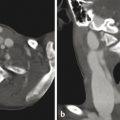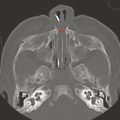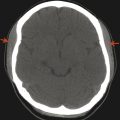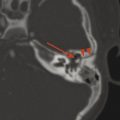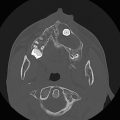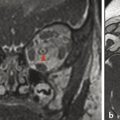18 Craniofacial
18.1 Introduction
Acquired and congenital craniofacial abnormalities can be intimidating because of the complex anatomy and apparent overlap of the clinical and imaging features of many of these entities. Regardless of the diagnosis, the ability to recognize the specific features demonstrated in a particular case of craniofacial abnormality can complement clinical and genetic information in making its diagnosis.
18.2 Anatomy
Although understanding craniofacial embryology is not necessary to the understanding of anatomy, knowledge of craniofacial development can help in the interpretation of anatomic abnormalities and deformities. For example, the first branchial arch normally fuses with the frontonasal process at 4 to 6 weeks of gestation, and failure of this fusion results in cleft lip. Another good example of the relationship between embryology and craniofacial anomalies is seen in branchial cleft cysts, which are further discussed in Chapter 17. Although craniofacial embryology is not reviewed here, the relationship between embryology and anatomy should be appreciated, and the embryology relevant to a particular anomaly is referenced if pertinent.
Ultimately, both pre- and postnatal development lead to the familiar structures of the human head and face. This chapter primarily focuses on the osseous anatomy of these structures.
The main bones of the face are the mandible and maxilla (Fig. 18.1a). The orbits are formed by multiple bones, including the maxillary, frontal, zygomatic, ethmoid, sphenoid, lacrimal, and palatine bones (Fig. 18.1b). The nose is formed by the maxilla and nasal bones, and the nasal septum by the vomer and ethmoid bones, along with cartilage. The forehead is predominantly supported by the frontal bone and the squamous portions of the temporal bones. The cheek is supported largely by the zygoma, a very important bone, which rigidly articulates with the maxillary, temporal, frontal, and sphenoid bones. The cranium is composed of flat bones creating the cranial cap (calvarium) and by a set of bones creating the cranial base. The anatomy of the skull, orbits, and oral cavity is discussed in further detail in Chapters 18, 21, and 23, respectively.


18.3 Facial Trauma
Facial trauma in children has patterns similar to those in adults, but identifying abnormalities in the setting of developing bones may be more complex than in mature bones. Additionally, it is important to attempt to use the most radiation-optimized diagnostic algorithm when imaging children.
Because mandibular fractures typically do not occur in isolation, it is important to follow the identification of such a fracture with an investigation for an occult secondary fracture. Alternatively, the disruption/displacement of the temporomandibular joint may serve as a second point of pressure release, instead of a second fracture being present (Fig. 18.2). Mandibular fractures are also often seen in conjunction with fractures of the spine. Additionally, greenstick-type bowing fractures can occur in the face in children just as they do in the extremities.

Complex maxillofacial trauma is sometimes described with the Le Fort classification system, which describes common patterns of facial skeletal trauma and can provide useful descriptors to surgeons. Because all subtypes of fracture in the Le Fort system involve fractures of the pterygoid plates, the finding of such a fracture should raise a degree of high suspicion for a Le Fort fracture. Fractures at other sites determine the type of a Le Fort fracture. Thus, for example, a Le Fort I fracture extends through the piriform rim and posterolaterally through the maxillary sinuses and zygomaticomaxillary buttress to the lower aspect of the pterygoid plates. With respect to a frontal view of the face, Le Fort I fractures are said to follow the distribution of a moustache. A Le Fort II fracture involves the nasal bridge and extends laterally through the orbit, down through the inferior orbital rim, and posteriorly through the zygomaticomaxillary buttress to the pterygoid plates. With respect to a frontal view of the face, Le Fort II fractures follow the distribution of the nasal bridge of a pair of eyeglasses. A Le Fort III fracture also involves the nasal bridge and extends from the nasal bones laterally through the orbit, but continues through the lateral orbital wall and inferiorly involves the zygomatic arch and pterygoid plate. With respect to a frontal view of the face, Le Fort III fractures follow the orientation of a pair of eyeglasses (Fig. 18.3).

Classically, Le Fort fractures are bilateral; the term hemi-Le Fort can be used for a fracture that is unilateral. In summary, all types of Le Fort fracture involve the pterygoid plates. Fractures classified uniquely by type in the Le Fort system include those involving the piriform rim (type I), inferior orbital rim (type II), and lateral orbital wall along with the zygomatic arch (type III). 1
Another important fracture pattern is one that involves the zygomaticomaxillary complex (ZMC), sometimes called a “tripod” fracture, although this is a misnomer because the pattern of injury in such a fracture has more than three components. As mentioned, the zygoma articulates with four other facial bones. In the setting of direct trauma, fracture can occur at the sites of any of these four sutures, which are: (1) the zygomaticofrontal (lateral orbit), (2) zygomaticosphenoid (orbital floor), (3) zygomaticotemporal (arch), and (4) zygomaticomaxillary (maxillary sinus and inferior orbital rim) sutures. If this fracture pattern is seen, a ZMC fracture can be documented, with additional information provided about the degree of displacement and adjacent tissue injury at each suture site.
Orbital trauma, including fractures of the orbital floor and medial orbital wall, is further discussed in Chapter 21.
Stay updated, free articles. Join our Telegram channel

Full access? Get Clinical Tree


